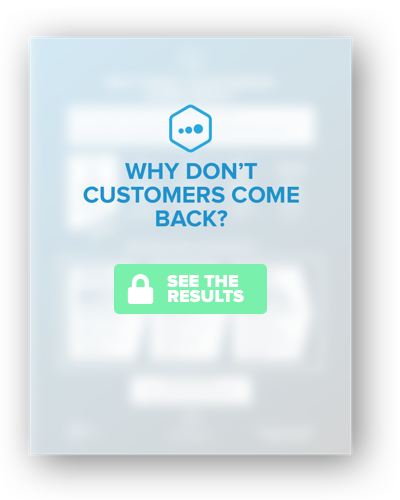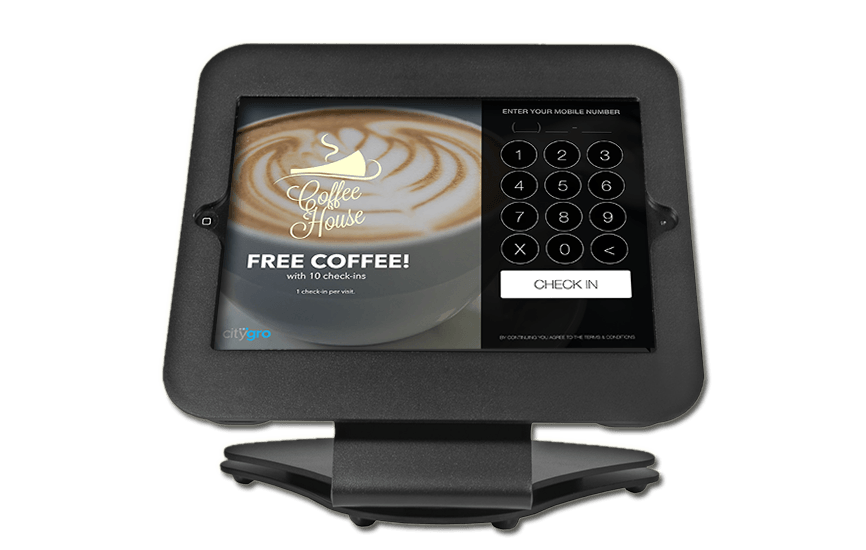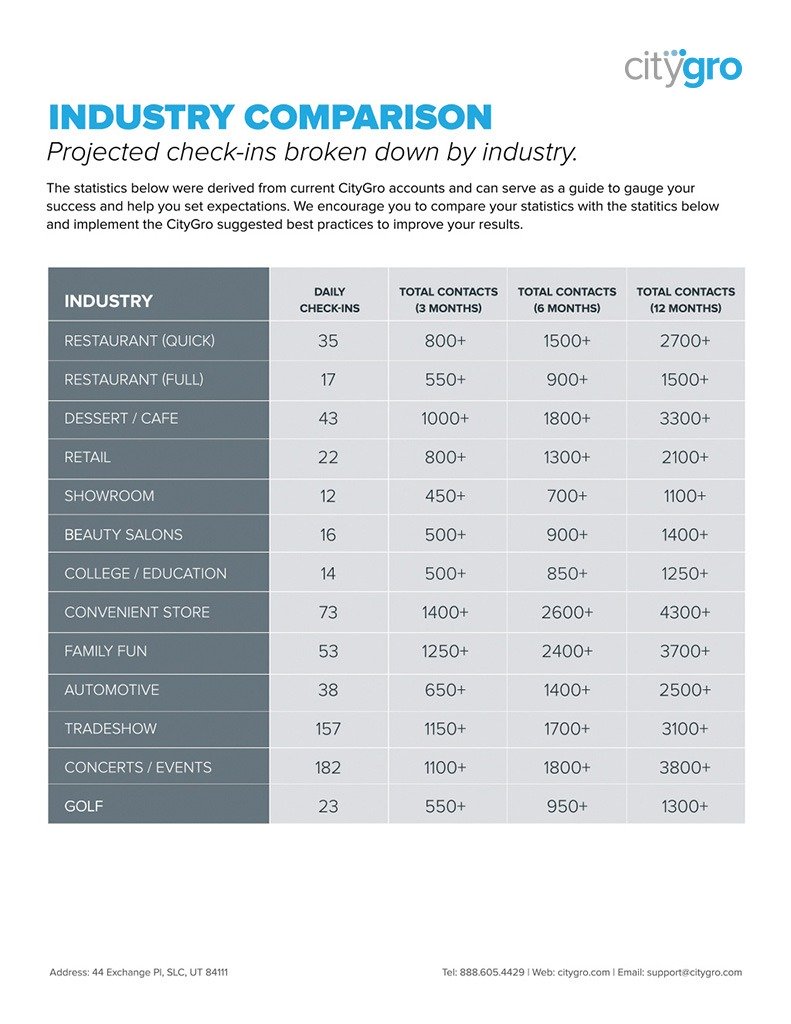Getting Customer Back to Your Restaurant
Getting traffic to your restaurant can be tricky. First, you have to get the customer into your store, 2nd, you have to get them to come back. Currently, restaurants are seeing on average a 70% defection rate after a customers’ first visit.
Read the transcript below to learn what you can do to get customers coming back to your restaurant.
TRANSCRIPT:
All right, we are live here in the city grow. We’re excited to have mandy with us today from our marketing team and we’re talking about restaurants.
Yeah, it’s good to be on this side of the camera to the other side with us. Every other camera outside. A little bit better than I am excited to be talking about today.
Well, so, so here’s city grow. We work with all kinds of different businesses. We worked with a lot of restaurants, a lot of principals carry over, so I guess in just kind of disclosing this, uh, this episode and it is going to hear towards restaurants, a lot of the same principles work with other industries so it can still be enlightening. We’re just going to tailor it to, to restaurants today. And as always, if you have questions, please leave comments below a, at the end. I’ll take a quick gander and see if we’ve had any questions and then we’ll try to answer us. But let’s just jump in. What are they, what are some of the big hurdles? Restaurants have a marketing.
So pretty much I see two big hurdles. One is getting new customers in the door, she’s like the traditional, what you think about marketing, but the second one I’ve actually run across as I think is the bigger hurdle is actually kidding customers come back. So latest study I saw showed that in most restaurants you 70 percent detection rate after their first visit, which as a marketer that just hurts my heart so bad, but it’s so hard to get them in and spent so much time, so much money coming back, which is awful. So that I think is the bigger of the two problems right now that restaurants are kind of basic.
And that’s so interesting too because you think of a marketing budget and I think if you ask most restaurant orders, like what? Uh, what is your marketing budget go towards, do you think? They usually say bringing in New York
100 percent. So I’m actually developing a course right now for restaurants people and I’ve been interviewing a lot of restaurant owners and that’s the one thing I’m going to ask them. Like, oh, what are you doing in market is, oh, we’re on doing facebook ads. And just other stuff to get awareness out, but none of them really had a plan to get customers come back.
Yeah. Which is huge.
You’re 70 percent that is most likely they’re not going to come back.
So why do you think you’re having such a hard time getting the company to the customers
come back? So I think there’s three main reasons when there’s just a lot of competition. There’s a lot of restaurants out there. I am too. I think that people are just kind of creatures of habit. Like I know me and my husband had like five restaurants that we kind of just rotate between them. They’re comfortable for asking me no doubt and we know will like the food so we kind of get stuck in that habit and three of the people just forget like it’s a Friday night, had a long work week and trying to figure out where I want them to go out to eat and I don’t want to. So I just go back to what I know. I forgot about all these new places. I don’t want to think about it. It’s just not top of mind. Which is really hurting restaurants, right?
I think you’re dead right. I think there’s a lot of businesses. You’re no longer the sole restaurant on main street. People have choices. They have choices at their fingertips. They can be looking at their phones. And where do I want to eat today? Oh, let’s see. The 40 places that are within walking distance. So. OK. So what have you found the most restaurant owners are doing to try to bring customers back?
Yeah, so like I was saying, I’ve been asking restaurant owners and every single one of them is kind of funny. Gave me the exact same answer. It was like had good food, having a service. That’s all they said. I’m like, well, if every restaurants having good food and every restaurant I’m saying good service and they’re still seeing 70 percent infection rates. Obviously that’s not working out so well. And so I got thinking like, oh, why are restaurants? I’ve got me coming back. Like I told you I have my five. I’m like, how did those five get me to come back to examples? Like the first one is a place called laid-back. Kobe Shaq, you’ve heard me talk about it. Everybody in the office has heard me talk about it because I love it so much. I mean it kind of how I heard about it as I was on instagram one day and my friend went there and they took a picture of it on their phone.
Disclaimer, I never follow restaurants on instagram because I’m always on a diet and I always see the picture and it ruins my diet, so I never followed these on instagram, but he had put a picture and I’m like, oh that looks good. I want to try it. So I decided to follow them on instagram just because of the name [inaudible] like, Oh, I’ve never heard of that for. I’ll forget about it by tomorrow, so I’ll follow. Unfollow him the next day so that no harm, no foul. Went there was good. I liked it and then I forgot to follow them a week later on my instagram feature, pokemon same picture. It reminded me like, Oh yeah, that was good. I need to go back there. Had I thought about [inaudible] since I’ve been there? No, not at all, but I’ve seen that picture reminded me. Oh yeah, that was good. I liked it.
I need to go back and the second example I have is a place costs weighed in college. My sister was like, oh, you gotta try this week. Place is the soda place. Yet I went and they asked me like, Oh, do you have a phone number to join our digital loyalty program? And I was like, oh sure. I love free things. So obviously I’m gonna give you my number. I gave him my number. I get texts like couple of days where you’re like, oh thanks for coming in, come back, we’ll give you a free sugar cookie. I’m like, well I love sugar. So obviously I have texts from him on Monday. Let me see. They texted me on Monday. We may be partially with, we think swing has the best cookies in town, free cookie of your choice with your next purchase. So obviously on Monday I went back because I got a note saying no. Had I even thought about going in, not at all, but that’s text reminding me that they. They’re reminded me that I liked them and you went back and it’s funny. They’re actually a client of us. I had no idea. I came up with our short code.
We were actually. A lot of it really comes down to the top of mind awareness. There are so many businesses out there. You might like dozens of them, but five of them stay top of mind because you either have been there so much. You you’d build a habit or they’re just reminding you enough that they’re getting into the top of mind awareness stage without you
building that. Hadn’t yet. Exactly right. Like how many times have you been talking to somebody and they say, Oh, we tried this restaurant and you remember, Oh yeah, I have tried that. I remember I really liked it. Never went back. That was like a year ago and I haven’t gone back. So that is the number one challenge at restaurants are really facing is how do I stay top of mind? How do I help people not forget that were there and that they like us.
Yeah. I had an interesting question come up in a in a sales meeting the other day when we were talking about a, if you are not reaching out to your customers who wins because that puts a big advantage. I looked at the stats. It’s not very high. The amount of businesses that actually engage their customers, so just by doing that piece, you’re already had advantage. Yeah, step above the 80 percent of restaurants out there because they just don’t do it.
I think a lot of restaurant owners are really scared to reach out because they think, oh, I don’t want to bug my customers. I don’t want it about them, but what they don’t realize is that people gave you their phone number. They want to be buttoned up and give you my number if I didn’t want you to use it like
so let’s say. I think you’re right. I think one of the bigger problems before they can decide whether they want to reach out or not is they don’t get to the information in the first place.
You’d be surprised just by asking for it. Most people will be willing to give you, like whenever I’ve been asked, I don’t think there’s been ever a time to I. Oh no, no, no. Don’t have my phone number because usually it’s attached to some kind of free offer. An incentive.
You like the place already?
Yeah, of course I’m going to give it. They just need to ask. And that’s a lot of restaurants don’t even think to ask. They don’t.
Yeah. Well, so, so let’s talk about this. So a lot of the methods we use are just digitizing standard processes. Like one of them wouldn’t be the loyalty system than a restaurant has. It’s very natural way to get people to give you information because it tracks every time they come in. What, uh, what have you found successful? Or how the restaurants getting more people into these digital systems, like digital loyalty systems that we’re texting, text lists, that kind of thing.
To break this down between two different types of restaurants, I think it’s a big difference between like the full service sit down and then the quick service go up to the cash register pay type of places. And the people that the quick service actually have a little bit of a leg up just because they have people congregating at the cash register, so you know that’s going to be appointed contact with your customer. It’s a good easy way, good place to ask them for their information. And with our customers, we’ve seen a lot of success having like a little kiosk, which is just a little ipad right up there at the register. All they do have to do is type in their phone number in there and I always recommend is make sure you have an incentive and make sure you had an incentive. Redeemable immediately say OK, 10 percent off or get a free to serve. If you say
do it today, they’re much more likely to say, yeah, sure, yeah.
I love restaurants. Owners are like, oh well if I do one that they have to come back to get that will serve two purposes, they’ll come back. But actually we exchanged that a lot less. People will sign up. It’s a future event. They get gratification. We wanted that kind of culture. So that’s a great way for those quick service for sit down restaurants a slower and more difficult because you’re not the only point of contact there really having is with the wait staff. So you need to really be training your wait staff to get that information and a lot of our customers have had little carry on cards at the, the, the way stock and hold it and be like, Hey, just so you know, we have this loyalty program. If you sign up, we’ll give you a free dessert and still be like, oh yeah, sure.
And that just was a little card. They sign it, that counts as consent. Just actually writing it down and saying that they have permission, which is great. And the waist after just go back and knowing their system just immediately put the phone number in and it’s just super simple process. Um, another way that a lot of the sit down restaurants, I’ve had successes with sms key words and that’s where people will just text in pizza to whatever short code and they’ll be automatically added. Again, just use your wait staff to let them know about the keyword is what number they need texts at into have. You can have table tents or posters. Just something at the time.
Yeah, we’ve seen some, a lot of success with kind of creating a multi channel approach to collecting that data. Or I remember a, a test we ran with iop to see what, how we could increase it. They called it the pancake revolution on these numbers. Right. And, and uh, the process they had in place was a form that you fill out and drop it in their plastic a bucket or whenever you drop it in there. And then somebody would take that data and put it in. So what we did there was really successful is, is uh, in the waiting room while somebody is waiting to be seated. We put a kiosk that they can sign up on. So, uh, it was busy. A lot of times they would just, they would sit there and they’d see it on the flow went where if they would punch it in on the kiosk, when they walk to the table, they get a text on their phone that says, congratulations, you’ve mentored. They would just have to show that the waiter and they were inside. That was the incentive, but sometimes when it wasn’t busy they would rock walk right by that key.
Yeah. They won’t be in the way
if I need a way to go right to the table. And like you said, we have a table [inaudible] on every, every table. They’re cheap. I mean there were like fifty cents to print on each one. You put them on there over a few weeks so you kind of just messed up a little messy. So we. They would just replay some sounds from those table tents. They said you have two options and it was kind of split in half sitting, one text a keyword and you were saying about that Smith to go back to the waiting room and on the way out there’s a no right now there’s chaos and we’ve watched what they did there and on top of that we had posters posted throughout and I think it was a 13 times increase over just the pattern. I mean it was astronomical, uh, how big that difference was. And then they have numbers on their side. They said once people are in that and the ability to reach them is x amount more profitable because then there’s always a huge deal to them really successful. That multi-channel approach worked really well.
Yeah, I really like that for two reasons. Like when it was really easy for customers to sign up, if it’s really difficult, like alarm for, I’m like, oh, I don’t want to sit down and write out all my information, just like, you know, Texas super easy. And I really liked that too because I’m, you don’t have to have somebody actually pulling out written things entering into your computer. Which one? Who’s to say you can even read that. Yeah, there’s gotta be a lot of human error on that site. And this whole time doesn’t mean like who has time to say it, like manually enter any of that information.
So. So I guess I wish should say that’s better than nothing, but there are, there are better ways to. OK. So let’s go back to the quick sir, because we’ve talked about full service restaurants a little bit and how does multi-channel works really well? And we talked a little bit about an incentive. If you can do it today, that’s better. The nice thing about a full service restaurants is he a tiny. You can maybe ask for a zip code, your gender. I mean having to fill out five or six fields in a quick serve. Fast paced. I’m racing through the line. The last thing I want to do is hold the line up. What are some things that we can do there to make sure that people get any gifts through and we’re not holding the line?
Yeah. The easiest thing to do is when you don’t want to ask it too much information. Like we’ve had places like ask like, oh, what toppings, what you’d like to see in the future. And just stuff like that. That really they’re not really going to use that information anyway, so if you’re going to use it, ask for it, but if you’re not, it’s probably best not to ask where, but two, they can just ask for just the phone number while they’re in line. Either they can enter in the kiosk or they can just ask for it at the register with just the phone number. They’ll have contact information. If they need further information, they can text it to them so that they’ll just have to click on the link on their phone and enter the information and they’re done. And that way you’re not going to hold up your line and showing the phone number takes less than three seconds.
Well that’s exactly what I wanted you to make. I’m glad you did because when you go through a restaurant and a quick serve or fast food, whatever it is, there is time where they’re checking you out. Did you just winning it only takes a few seconds. Put it in a phone number. That’s why they’re probably getting more phone numbers in restaurants who emails. Um, and it’s worked really well to send them a thank you for coming in text. Maybe here’s a bounce back to come back within the next seven days. By the way, did you want to sign up for free food on your birthday? Maybe a free dessert or something. Click here.
I give them incentive to get more information. Yeah.
Cool. So yeah, I, there are a lot of good ways to do it without holding up the line and uh, I guess the big hitter is just capturing information because like you said, it’s nice to have the decision on do I want to reach out to my customers or not? If you haven’t built a database, you can,
like any campaign you’re going to be sending out is only going to be as good as the network you’re [inaudible] have only had 10 people on sending a message out to maybe is going gonna come back and that was a super successful. Whereas if they had 3000 people, I’m sending you 10 percent of them come in. That’s three months customers. That’s a big deal. Yeah.
By the way, on percentages, just uh, just to kind of frame of reference there, and I’ve done some research on this lately. If you get like mailers in the mail for three percent is high rejection rate. The I believe zero or anywhere one just below or above is kind of average people do. But I mean there’s a time and a place for those and do like more on the shelf coupons, grocery stores and stuff like that. You’ll get higher, like four or five percent. We’ve seen as high as eight to 12 percent, which is awesome. But it really comes back to Dr. Campaign. So let’s, let’s talk about that. We’re talking about restaurants specifically specific to restaurants. What campaigns are we running that are working,
so we’ve kind of talked about it before, but I really liked the bounce back offer because it’s that first visit is where you see the highest drop off of customers, so with a bounce back offer you’re going to hit that window most vulnerable to leave. You’re going to give them good incentive to come back and buy one, get one or buy byline, get free to it, just some kind of incentive to come back, give it a relatively short expiration date, like even maybe like a week or two to come into your restaurant.
Yeah, last year, somewhere in there. Sounds so short
so that they’re not forgetting because it’s the same issue. If I see it, I’m like, Oh, I’ve got all the time in the world to redeem this. I’ll forget about it. Give it, give it a couple of days. I’ll have new tests, new information. I won’t be thinking about it, but
they would say something like, thanks for coming in. Come back within the next x days, three, four or five days and get x amount off. Whatever promotion you’re giving them.
One I’ve lived like I get asked all the time like why campaign tonight you on one night really lovely at least half birthday campaigns and promotions. Like I love promotions on my birthday and I usually redeem a couple of them but my birthday is only so long and there’s only so many ice cream I can eat on my birthday, but if I get one I have never gotten one personally on a half hour a day. And like that is a huge opportunity. If I got it through something on my half birthday I would for sure be in and out
for some reason to party. But you didn’t even think about.
Yeah, I didn’t even think about it and not being any other messages. So it’s not that, that issue of overcrowding and I’m going to obviously bring my husband and bring whoever with me so that’s going to be profitable for them even though they’re giving away more free stuff is still going to be profitable. I love half birthday campaigns.
Um, celebration anniversary, birthday campaigns. Thinking people celebrate those in groups, right? I mean, some people will go out through themselves right on, on their birthday alone or whatever, but a lot of people. It’s a group.
Yeah. So giving away one free mail you’re gonna get.
Yeah. For your promotions to that. So instead of doing half off buy one, get one free or buy one, get one half off. Um, they just, people, we like excuses to celebrate. You celebrate yourself. Deal birthday march when spring brings three others, I buy three. Get one completely free like that. That’s, that’s how we really promote kinds. Be Great.
Yeah, that’s great. For Birthdays and the one that we see the most success for it will probably say grow is just ones that are interval where it’s like, oh, we have it set up. So if you haven’t seen a customer three to five weeks, whatever time you want, it’ll send a text message just automatically. You don’t have to actually send it out. And that will be automatic little promotion. Like, oh, we haven’t seen you while come to get a free drink. That’s a big one was that I got the cookie wasn’t one of those folks I hadn’t been in for I think a couple of months, so I got that message and those are the best because it reminds customers that haven’t been in for awhile, so they’re the ones most likely to come back in because they’ve likely forgotten about you, so it’s going to be the most effective and you can set it up. So they actually, we absolutely always recommend to you to one, uh, a small promotion at a smaller time period if that didn’t work, hit them with a better promotion just a little bit farther down the road. Awesome. And we see a lot of success with that kind of campus.
So it seems like a lot of it comes back to like context, right? I’m thinking of you in what you would celebrate or thinking of our customers when they celebrate. What about the timing aspect of campaigns is helpful? Um, maybe time of day or time of week. How does that play into a successful campaign?
Yeah. So especially if it’s a text campaign, you were wanting to send that to them when they’re thinking about it. Like if I am making dinner plans, I might be making dinner kind of somewhere between three and five text messages are most immediately so you don’t need to send it anytime before hand and just say exactly when. People will be thinking about if I get a text about a dinner promotion at 9:00 at night, I’m likely not going to use that because by the time I need dinner the next day I’ll have forgotten about it. So it’s me. It’s really good to make sure you’re getting the right message to the right person, the right time. That’s always our marketing mantra. So right message, right person, right time. You want to get to the person most likely to act at the time but most likely to.
So you might even want to segment your customers a little bit because let’s say people from you for a lot of people do it. They eat at your restaurant for lunch, day in, day out, but they’ve never been there for dinner because they live 45 minutes away in a community in, so you might have a lunch list and a dinner list and you could try and cross promoting a little bit to see if you could get. Your customers will come back or you might just say, OK, your lunchbox for I’m going to send it to you like 11, 10 or 11 in the morning knowing that you’re. You’re starting to get hungry.
Yeah. That’s a great thing about having good crm is going to track when people are coming in and what times of day they’re coming in and that’s to do with that relevancy. Like if I set up my system to send out a message three weeks from the last time they came in and began to get it at the same time of day that they were in last time, which makes it a heck of a lot more relevant than if I had just sent it.
Whatever title I thought I wanted to do. So. And then the other thing that came to my mind is, is discounting. You got to think about the context of discounting too, because what we’ve seen is if somebody is already in your store and you’re trying to come up with an incentive, get them to pull out their phone number on the list. It doesn’t take as much to get the phone number when they’re already in your store as it does to get them off their couch to come to this. So you might just find that with a free Dream Corp something. Don’t break the bank. You can get them to add their information in.
Yeah. Honestly, I think what that example, they didn’t even give me everything that you just asked me. I was asked me by the phone number and said I’ll get free stuff and just first I’m going to join. I have free stuff down the road. Like I said, Trey, how’s the restaurant? I would try it out, try it out. Maybe it was just a tiny promotion for see if you can get away with just offering promotions down the road and like see what’s working for Steven. What is getting you the most opt-ins because the bigger your list is, like I said, the better year
you can try this month. Just asking next month, maybe out an incentive change incentive company.
Compare your numbers yet your work. Yeah.
Awesome. Any other campaigns that come to mind? Do you think we’ve covered covered campaign zero?
I think I yam, I’m talking about anniversaries. I really liked the anniversaries of like when they first came to your restaurant, like I think that’s a really fun idea. Like one year ago today you came here for the first time we want to sell it right when we first met like we have, we have an anniversary gift for you. Just little creative, get creative, like do stuff that you don’t see other restaurants doing.
It’s become really popular for, at least for us is is a sequence of messages that get a little bit better over time. Right. If you’re new to my store, you came in a week ago. If I can get you back without offering a promotion, maybe just telling you a new item on my menu or something exciting, I’m going to give that a shot. See if it brings you that doesn’t work, then I can trigger another message a couple of weeks later. It’s still a little bit of a discount and so I can see like, yeah, it didn’t work the first time. Let’s see if it will work up the discount and then. So it’s really common, especially in a restaurant where we expect people to come back every couple of weeks to do like a bounce back, like you said, than a two week, four week, six week and eight week, and then the longer goes. You might spend it out a little bit more, get that message better and better until finally you think, OK, it’s been six months since they’ve come in on going to just give away the farm
free state dinners.
Yeah, and then you’ve gotta think of lifetime value, right? Because maybe maybe you’ll just break in or you didn’t, or maybe you want to give us something that you’re going to lose a little bit on just to get them back in
customer. Like how much money am I spatially back? Pro-Gay Shaq. We go twice a month for three years. Same cost. So much money from us. But yeah, something I actually wanted to touch on that we haven’t really touched on yet is just like the traditional Finnish Guy, right? Buy Ten, get one free with this is what the digital one is so much easier. You don’t have to hold on to that little card that you’re going to lose anyways. Like how many of those little cards have you lost all your lifetime digital. You can have them after every time they come in, you can set up a message that says, OK, you are eight purchased away from your free whatever. Next week you’re seven. Like just some kind of message letting you know how close the eyes and yeah, getting close and then they don’t have to keep track of that little pesky little card.
They come in or out or you can remind them with. Thank you. You’re now two more [inaudible]
yeah, and it’s good for restaurant owners to. Because by making that punch card digital, they’re not getting their contact information. They now see when they come in and seeing him all kinds of data. Whereas if you just hand out a piece of paper and hope they come back, you’re not getting much. Never. No goodbye. Goodbye. Yeah.
Cool. Well I think we’ve covered a lot. I think, uh, I hope it was useful for everyone. Um, I don’t see any questions, so we’ll go ahead and wrap up if you guys have any questions. We do monitor this before and after I, we’ll look at it. Please feel free to hit us up and we will respond. Thanks for being with us guys.






 Get this section from Jon. Get this section from Jon. Get this section from Jon. Get this section from Jon. Get this section from Jon. Get this section from Jon. Get this section from Jon. Get this section from Jon. Get this section from Jon.
Get this section from Jon. Get this section from Jon. Get this section from Jon. Get this section from Jon. Get this section from Jon. Get this section from Jon. Get this section from Jon. Get this section from Jon. Get this section from Jon.

